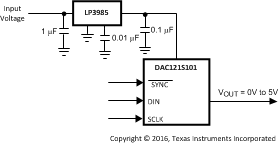SNAS410F May 2008 – July 2016 DAC121S101QML-SP
PRODUCTION DATA.
- 1 Features
- 2 Applications
- 3 Description
- 4 Revision History
- 5 Pin Configuration and Functions
-
6 Specifications
- 6.1 Absolute Maximum Ratings
- 6.2 ESD Ratings
- 6.3 Recommended Operating Conditions
- 6.4 Thermal Information
- 6.5 DAC121S101QML-SP Electrical Characteristics DC Parameters
- 6.6 DAC121S101QML-SP Electrical Characteristics AC and Timing Characteristics
- 6.7 DAC121S101QML Electrical Characteristics Radiation Electrical Characteristics
- 6.8 DAC121S101QML-SP Electrical Characteristics Operating Life Test Delta Parameters TA at 25°C
- 6.9 Typical Characteristics
- 7 Detailed Description
- 8 Application and Implementation
- 9 Power Supply Recommendations
- 10Layout
- 11Device and Documentation Support
- 12Mechanical, Packaging, and Orderable Information
9 Power Supply Recommendations
9.1 Using References as Power Supplies
Recall the need for a quiet supply source for devices that use their power supply voltage as a reference voltage.
Because the DAC121S101QML-SP consumes very little power, a reference source may be used as the supply voltage. The advantages of using a reference source over a voltage regulator are accuracy and stability. Some low-noise regulators can also be used for the power supply of the DAC121S101QML-SP. The following sections describe a few power supply options for the DAC121S101QML-SP.
9.1.1 LM4050QML-SP
The LM4050QML-SP is a space-grade, radiation-qualified shunt reference within an accuracy of ±0.1% at room temperature and a temperature coefficient of 23 ppm/°C.
 Figure 40. The LM4050 as a Power Supply
Figure 40. The LM4050 as a Power Supply
The minimum resistor value in the circuit of Figure 40 must be chosen such that the maximum current through the LM4050 does not exceed its 15-mA rating. The conditions for maximum current include the input voltage at its maximum, the LM4050 voltage at its minimum, the resistor value at its minimum due to tolerance, and the DAC121S101QML-SP draws zero current. The maximum resistor value must allow the LM4050 to draw more than its minimum current for regulation plus the maximum DAC121S101QML-SP current in full operation. The conditions for minimum current include the input voltage at its minimum, the LM4050 voltage at its maximum, the resistor value at its maximum due to tolerance, and the DAC121S101QML-SP draws its maximum current. These conditions can be summarized as:
and
where
- VZ(min) and VZ(max) are the nominal LM4050 output voltages ± the LM4050 output tolerance over temperature
- IZ(max) is the maximum allowable current through the LM4050
- IZ(min) is the minimum current required by the LM4050 for proper regulation
- IA(max) is the maximum DAC121S101QML-SP supply current
- IA(min) is the minimum DAC121S101QML-SP supply current
9.1.2 LP3985
The LP3985 is a low-noise, ultra-low dropout voltage regulator with a 3% accuracy over temperature. It is a good choice for applications that do not require a precision reference for the DAC121S101QML-SP. It comes in 3-V, 3.3-V, and 5-V versions, among others, and sports a low 30-µV noise specification at low frequencies. Because low frequency noise is relatively difficult to filter, this specification could be important for some applications. The LP3985 comes in a space-saving 5-pin SOT-23 and 5-bump DSBGA packages.
 Figure 41. Using the LP3985 Regulator
Figure 41. Using the LP3985 Regulator
An input capacitance of 1 µF without any ESR requirement is required at the LP3985 input, while a 1-µF ceramic capacitor with an ESR requirement of 5 mΩ to 500 mΩ is required at the output. Careful interpretation and understanding of the capacitor specification is required to ensure correct device operation.
9.1.3 LP2980-N
The LP2980-N is an ultra-low dropout regulator with a 0.5% or 1% accuracy over temperature, depending upon grade. It is available in 3-V, 3.3-V, and 5-V versions, among others.
 Figure 42. Using the LP2980-N Regulator
Figure 42. Using the LP2980-N Regulator
Like any low-dropout regulator, the LP2980-N requires an output capacitor for loop stability. This output capacitor must be at least 1 µF over temperature, but values of 2.2 µF or more will provide even better performance. The ESR of this capacitor must be within the range specified in the LP2980-N data sheet. Surface-mount solid tantalum capacitors offer a good combination of small size and ESR. Ceramic capacitors are attractive due to their small size but generally have ESR values that are too low for use with the LP2980-N. Aluminum electrolytic capacitors are typically not a good choice due to their large size and have ESR values that may be too high at low temperatures.